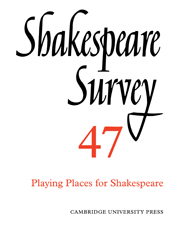Book contents
- Frontmatter
- Shakespeare Played Small: Three Speculations about the Body
- The Architecture of the Fortune Playhouse
- The Bare Island
- ‘How Chances it they Travel?’ Provincial Touring, Playing Places, and the King’s Men
- Writing for the Metropolis: Illegitimate Performances of Shakespeare in Early Nineteenth-Century London
- The Perishable Body of the Unpoetic: A. C. Bradley Performs Othello
- Playing Places for Shakespeare: The Maddermarket Theatre, Norwich
- ‘A Fairly Average Sort of Place’: Shakespeare in Northampton, 1927–1987
- The Living Monument: Self and Stage in the Criticism and Scholarship of M. C. Bradbrook
- Stratford Stages: Interviews with Michael Reardon and Tim Furby, and Sam Mendes
- Dis-Covering the Female Body: Erotic Exploration in Elizabethan Poetry
- Theseus’ Shadows in A Midsummer Night’s Dream
- ‘Time for Such a Word’: Verbal Echoing in Macbeth
- Shakespeare’s Knowledge of Italian
- Tamburline and Edward Alleyn’s Ring
- Shakespeare Performances in England, 1992–1993
- Professional Shakespeare Productions in the British Isles, January-December 1992
- The Year's Contributions to Shakespeare Studies 1 Critical Studies
- 2 Shakespeare’s Life, Times, and Stage
- 3 Editions and Textual Studies
- Books Received
- Index
3 - Editions and Textual Studies
Published online by Cambridge University Press: 28 March 2007
- Frontmatter
- Shakespeare Played Small: Three Speculations about the Body
- The Architecture of the Fortune Playhouse
- The Bare Island
- ‘How Chances it they Travel?’ Provincial Touring, Playing Places, and the King’s Men
- Writing for the Metropolis: Illegitimate Performances of Shakespeare in Early Nineteenth-Century London
- The Perishable Body of the Unpoetic: A. C. Bradley Performs Othello
- Playing Places for Shakespeare: The Maddermarket Theatre, Norwich
- ‘A Fairly Average Sort of Place’: Shakespeare in Northampton, 1927–1987
- The Living Monument: Self and Stage in the Criticism and Scholarship of M. C. Bradbrook
- Stratford Stages: Interviews with Michael Reardon and Tim Furby, and Sam Mendes
- Dis-Covering the Female Body: Erotic Exploration in Elizabethan Poetry
- Theseus’ Shadows in A Midsummer Night’s Dream
- ‘Time for Such a Word’: Verbal Echoing in Macbeth
- Shakespeare’s Knowledge of Italian
- Tamburline and Edward Alleyn’s Ring
- Shakespeare Performances in England, 1992–1993
- Professional Shakespeare Productions in the British Isles, January-December 1992
- The Year's Contributions to Shakespeare Studies 1 Critical Studies
- 2 Shakespeare’s Life, Times, and Stage
- 3 Editions and Textual Studies
- Books Received
- Index
Summary
Well then; the promised hour is come at last; The present Age of Wit obscures the past:
It may seem a little extravagant to use Dryden’s lines on Congreve to introduce a fully annotated text of King Lear based on the Folio alone, but after so much talk and work, it is a moment of some interest. One question worth asking about recent textual work on Shakespeare is whether the past ten or so years have witnessed an editorial revolution or, less dramatically, a publishing one. Of course, some important matters have been valuably addressed, from the difficulties posed by modernization to the relationship between literary and theatrical texts. But the steady flow of impressive volumes from Cambridge and Oxford may make the reader occasionally pause to wonder how different in practice these editions are from those of a decade or more ago.
Jay L. Halio's edition of what has been called 'the bibliographer's Everest', King Lear? is large and generous, with a lengthy critical and historical introduction and over eighty pages devoted to textual matters, including detailed comparisons of Q/F parallel passages and fully edited versions of Q-only passages. Halio takes a modest view of the editor's role; he is clear sighted and level headed, accurate and in control of his material. The result is an edition of the play which consolidates much recent Lear scholarship and brings aspects of its textual and theatrical history into sharp focus. It allows the reader to reconstruct most of the story - or at least one version of it - and gain access to the materials behind the play's two texts.
- Type
- Chapter
- Information
- Shakespeare Survey , pp. 259 - 276Publisher: Cambridge University PressPrint publication year: 1994

